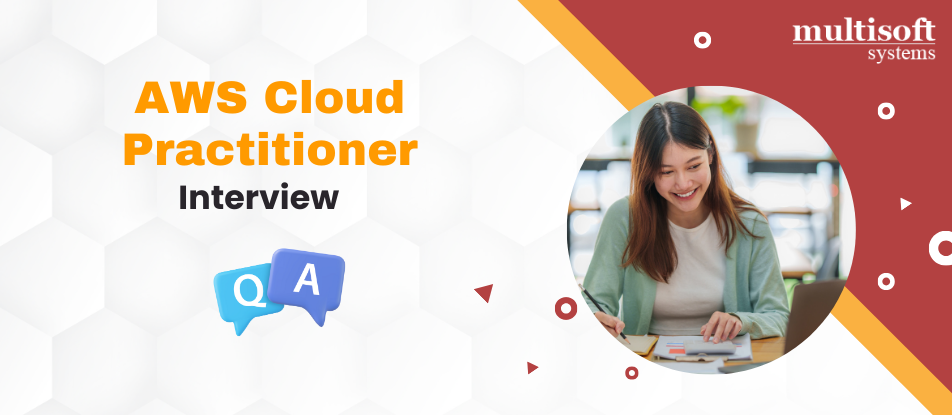
Learn the fundamental concepts of AWS Cloud computing with our AWS Cloud Practitioner Essentials Training. This course covers key services, security aspects, and architectural principles of AWS, preparing you for the AWS Certified Cloud Practitioner exam. Ideal for beginners, it provides hands-on experience in navigating the AWS Management Console and understanding the basic global infrastructure of AWS. Gain foundational knowledge essential for a career in cloud technology and AWS services management.
1. What is AWS?
AWS (Amazon Web Services) is a comprehensive, evolving cloud computing platform provided by Amazon. It offers a wide range of services including computing power, storage options, networking, databases, machine learning, and more.
2. What are the key components of AWS?
The key components of AWS include:
- Compute Services (e.g., EC2, Lambda)
- Storage Services (e.g., S3, EBS)
- Database Services (e.g., RDS, DynamoDB)
- Networking Services (e.g., VPC, Route 53)
- Management Tools (e.g., CloudFormation, CloudWatch)
3. Explain the difference between scalability and elasticity.
Scalability refers to the ability of a system to handle increasing workload by adding resources. Elasticity is the ability to automatically or dynamically provision and de-provision resources to match the demand.
4. What is S3?
Amazon Simple Storage Service (S3) is a scalable object storage service designed to store and retrieve any amount of data from anywhere on the web. It provides durability, availability, and scalability.
5. What is EC2?
Amazon Elastic Compute Cloud (EC2) is a web service that provides resizable compute capacity in the cloud. It allows users to rent virtual servers (instances) and run applications on them.
6. What is a VPC?
A Virtual Private Cloud (VPC) is a virtual network dedicated to your AWS account. It provides isolation and security for your resources within the AWS cloud.
7. What is IAM?
AWS Identity and Access Management (IAM) is a service that helps you control access to AWS resources. It enables you to manage users, groups, roles, and their permissions.
8. What is the difference between a region and an Availability Zone?
A region is a geographical area containing multiple Availability Zones. An Availability Zone is one or more discrete data centers, each with redundant power, networking, and connectivity, housed in separate facilities.
9. What is CloudWatch?
Amazon CloudWatch is a monitoring and observability service for AWS resources and applications. It collects and tracks metrics, monitors log files, sets alarms, and automatically reacts to changes in AWS resources.
10. What is Auto Scaling?
Auto Scaling is a feature of AWS that automatically adjusts the number of EC2 instances in a group based on demand. It helps maintain application availability and allows you to scale resources up or down as needed.
11. What is RDS?
Amazon Relational Database Service (RDS) is a managed database service that makes it easy to set up, operate, and scale relational databases in the cloud. It supports various database engines such as MySQL, PostgreSQL, Oracle, and SQL Server.
12. What is DynamoDB?
Amazon DynamoDB is a fully managed NoSQL database service that provides fast and predictable performance with seamless scalability. It is designed to handle large-scale, high-traffic applications.
13. What is Route 53?
Amazon Route 53 is a scalable and highly available Domain Name System (DNS) web service. It translates domain names into IP addresses and routes users to the correct resources.
14. What is CloudFormation?
AWS CloudFormation is a service that enables you to create and manage AWS infrastructure as code. It allows you to define templates for your resources and automatically provision them in a predictable and repeatable way.
15. What is the Shared Responsibility Model?
The Shared Responsibility Model delineates the security responsibilities between AWS and the customer. AWS is responsible for the security of the cloud infrastructure, while the customer is responsible for securing their data and applications in the cloud.
16. What are the different pricing models in AWS?
AWS offers various pricing models including On-Demand Instances, Reserved Instances, Spot Instances, and Savings Plans. Each model has different cost structures and benefits depending on the usage pattern and requirements.
17. What is the AWS Free Tier?
The AWS Free Tier is a set of free-tier offers provided by AWS for new customers to explore and try out AWS services for a limited time period. It includes limited usage of select AWS services with no cost.
18. What is the AWS Well-Architected Framework?
The AWS Well-Architected Framework provides guidance to help architects build secure, high-performing, resilient, and efficient infrastructure for their applications. It consists of design principles, best practices, and guidelines for architecting workloads in the cloud.
19. What is CloudTrail?
AWS CloudTrail is a service that enables governance, compliance, operational auditing, and risk auditing of your AWS account. It provides a history of AWS API calls made on your account, including details such as the identity of the caller, the time of the call, and the request parameters.
20. What are the benefits of using AWS?
Some benefits of using AWS include scalability, flexibility, cost-effectiveness, reliability, security, global reach, and ease of use. It allows businesses to innovate faster, reduce time to market, and focus on their core competencies.